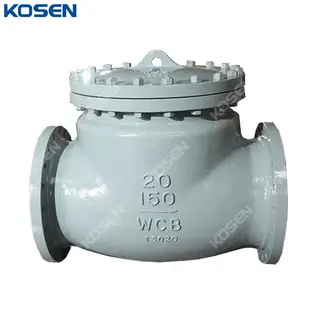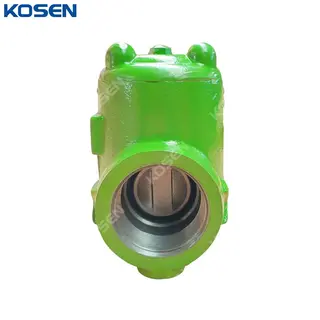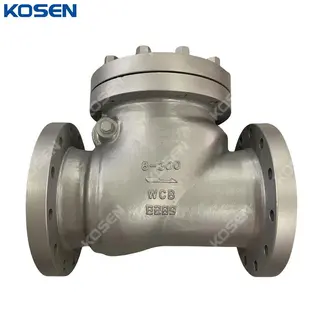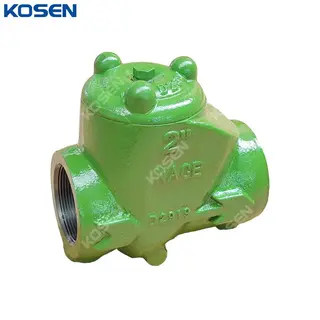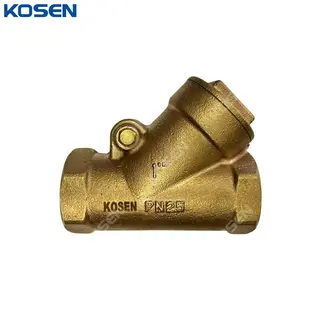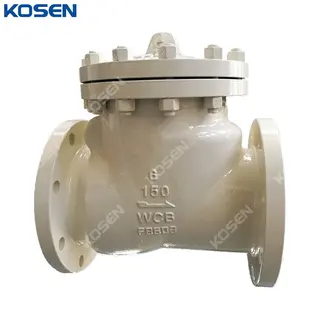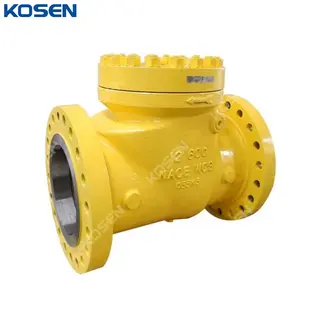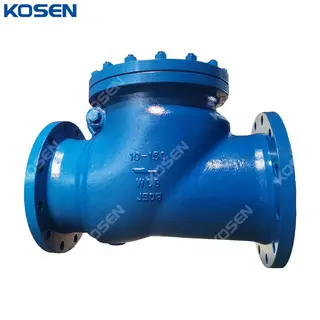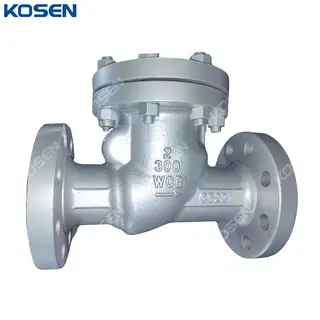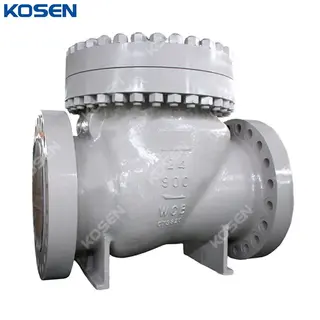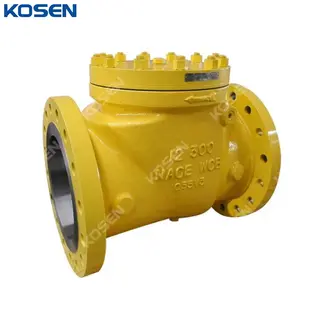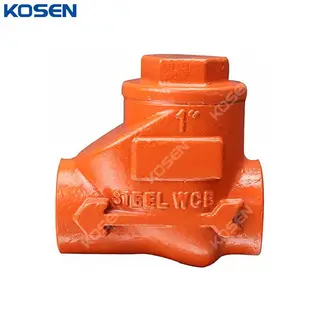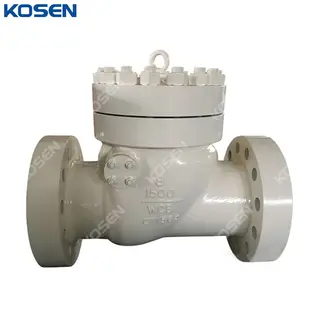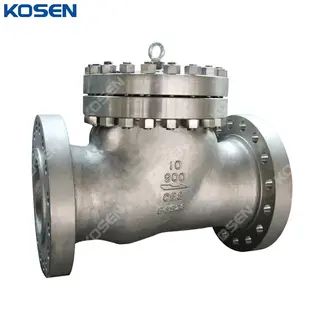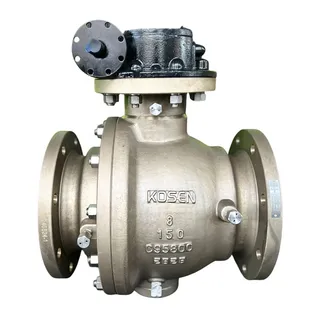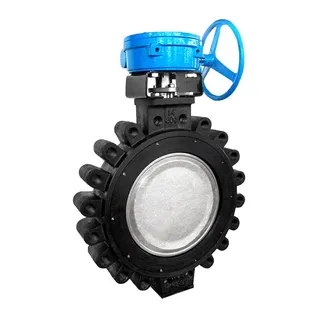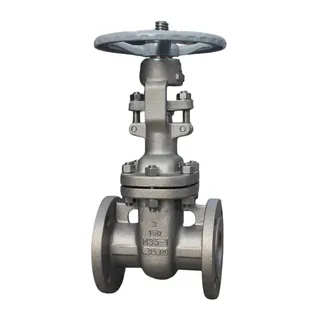A check valve is an automatic valve primarily designed to prevent backflow of the medium. It relies on the flow of the medium itself to automatically open and close the valve disc, ensuring that the fluid flows in only one direction. Other common names for check valves include non-return valves, one-way valves, backflow valves, and backpressure valves. The main functions of a check valve are to prevent backflow, avoid pump and motor reversal, and prevent leakage of the medium from containers. Additionally, it provides supply to auxiliary systems, especially in cases where the system pressure might exceed normal operating pressure.
The working principle of a check valve is based on changes in fluid pressure. When fluid flows, the fluid pressure pushes the valve disc open, allowing smooth flow of the medium. When the fluid stops flowing or flows in reverse, the valve disc automatically closes, preventing backflow. Specifically, when the fluid flows toward the outlet end of the check valve, the valve disc opens under the influence of the fluid pressure. When the fluid flows backward or stops flowing, the valve disc closes due to the spring pre-load or its own weight, thus preventing backflow.
Check valves come in two common types:
Swing Check Valve: The valve disc opens and closes by rotating around its center of gravity, suitable for applications with large pipe spaces and high flow rates.
Lift Check Valve: The valve disc moves vertically along the axis, ideal for applications requiring precise control of fluid flow.
The valve disc design considers the impact force and pressure changes of the fluid, allowing it to open and close flexibly, ensuring smooth fluid flow. The sealing performance of the valve disc is also optimized to prevent fluid leakage when the flow stops. The combined effect of the spring pre-load and the valve disc's weight enables the check valve to automatically perform backflow prevention without manual operation.
Depending on their structure and operating principle, check valves can be classified into several types, each with its own characteristics and applications. Below are the common designs and structures of check valves:
This valve type is automatically controlled by fluid pressure to open and close. When the fluid pressure exceeds the preset opening pressure, the valve opens, allowing flow; when the fluid pressure falls below the preset closing pressure, the valve closes, preventing backflow. Lift check valves are widely used in water supply systems, sewage treatment systems, and other fields, offering high automation control.
The valve disc in a swing check valve rotates to control fluid flow. This valve has a simple structure and good sealing performance, capable of stable operation under high temperatures and pressures. Swing check valves are commonly found in pipeline systems in the oil, chemical, and metallurgy industries, suitable for environments that require high fluid control.
A wafer check valve uses a disk-shaped plate as its valve disc and rotates this plate to control fluid flow. It is compact, flexible in operation, and effective in regulating fluid flow. Wafer check valves are widely used in water supply and drainage systems, air conditioning systems, and other fields, appreciated for their simple structure and easy installation.
A ball check valve uses a ball as the valve disc, and its rotation controls fluid flow. This valve has good sealing performance and low flow resistance, particularly suitable for controlling high-viscosity fluids. Ball check valves are commonly used in the oil, chemical, and food industries, ensuring efficient fluid circulation and long-term stable operation.
Check valves, due to their function of preventing backflow, are widely applied across various industries to ensure the safe operation of equipment and the stability of systems. Here are some key application areas.
Petrochemical Industry: In the petrochemical industry, check valves are used to prevent the reverse flow of crude oil, refined oil, and other fluids, protecting pipeline systems from potential safety hazards caused by backflow.
Municipal Water Supply Systems: Check valves play an important role in city water supply systems by preventing potable water from flowing back into the supply network, ensuring water quality and preventing contamination or system malfunctions.
Pharmaceutical Industry: In the pharmaceutical industry, check valves prevent the reverse flow of pharmaceutical liquids, ensuring the purity and safety of pharmaceutical production and meeting strict quality control standards.
Heating Systems: In heating systems, check valves prevent the backflow of hot water, ensuring the proper functioning of heating systems and preventing damage from water backflow.
Food Processing: In food processing, check valves prevent the reverse flow of raw food materials, ensuring hygienic safety during processing and meeting the stringent quality control requirements of the food industry.
Check valves play a critical role in equipment, devices, and pipelines by preventing backflow. Proper selection and installation are essential for ensuring the safe and stable operation of systems. Below are some key points and recommendations for selecting and installing check valves.
Applicable Medium: Check valves are typically suited for clean media and should not be used for media containing solid particles or high-viscosity substances. For pipelines prone to water hammer, special diaphragm check valves can be selected.
Nominal Diameter and Pipeline Type: For pipelines with a nominal diameter of less than 50mm, vertical lift check valves or straight-through lift check valves are recommended. For medium and high-pressure pipelines with diameters between 50mm and 600mm, swing check valves are suggested. For medium and low-pressure pipelines with diameters between 200mm and 1200mm, ball check valves are appropriate. For low-pressure pipelines (greater than 50mm but less than 2000mm), wafer check valves and diaphragm check valves can be chosen.
Vertical Lift Check Valve: Usually installed in vertical pipelines, offering excellent sealing performance, especially in high-pressure systems.
Swing Check Valve: Can be installed in horizontal, vertical, or inclined pipelines. For vertical installations, the medium should flow upwards from the bottom. This valve is suitable for large-diameter, low-pressure environments and can withstand high operational pressures (up to 42MPa).
Wafer Check Valve: Can be installed in horizontal, vertical, or inclined pipelines, suitable for large-diameter, low-pressure applications with flexible installation options.
Incompressible Fluids: When selecting a check valve for incompressible fluids, evaluate the required closing speed and choose a valve that can provide it.
Compressible Fluids: For compressible fluids, the selection method is similar but adjusted according to the medium's flow characteristics. For applications requiring rapid stopping and starting (such as compressor outlets), lift check valves are recommended.
Check valves are widely used in various pipeline systems to prevent backflow. The selection and application depend on the medium, pressure, temperature, and pipeline conditions. Below is an analysis of the advantages and disadvantages of check valves and their different types.
Simple Structure: Check valves have a simple design, typically consisting of the valve body, disc, and seat, which makes them easy to manufacture and maintain.
Easy Maintenance: Due to their simple design, check valves are relatively easy to maintain and service.
Good Sealing Performance: Check valves effectively prevent backflow with reliable sealing.
Energy Efficient: Check valves operate based on the pressure differential of the medium itself, requiring no additional power devices, thus saving energy.
Low Cost: Compared to other types of valves, check valves are less expensive to manufacture and offer high cost-effectiveness.
High Reliability: Check valves have a long service life and are widely used in various fluid systems.
Flow Resistance: The internal structure of check valves generates fluid resistance, which can increase energy consumption in the pipeline system.
Pressure Loss: In systems with significant pressure fluctuations, check valves can cause pressure loss, potentially impacting pipeline stability.
Difficult Cleaning: The internal structure of check valves can accumulate dirt and sediment over time, making cleaning and maintenance more challenging.
Check valves play a crucial role in preventing backflow within pipeline systems. However, like any mechanical component, they may encounter some common issues. Below are the typical problems and their respective solutions.
Cause: The pressure on both sides of the valve approaches equilibrium, leading to frequent disc impacts with the valve seat, especially with brittle materials like cast iron or brass.
Prevention: Use more resilient materials such as stainless steel or alloys for the valve disc to reduce damage from impacts.
Cause: Wear or corrosion of the sealing surface, or impurities in the medium clogging the sealing surface, preventing proper sealing.
Solution: Clean the sealing surface, regrind or replace seals, and regularly maintain the valve to prevent buildup of clogging particles.
Cause: Wear or damage to the valve disc or sealing surface causes poor sealing, leading to leaks.
Solution: Check for wear on the sealing surface. If severely worn, replace the seals; if mildly worn, consider polishing the surface.
Cause: Debris or deposits inside the valve obstructs movement, causing the valve disc to stick.
Solution: Disassemble the valve and clean the internal components. If the problem persists, replace the valve disc or core.
Cause: Loose or damaged sealing surfaces result in loss of sealing integrity.
Solution: Tighten the sealing surface or replace damaged seals.
Cause: Corrosion or overuse of the spring, causing a loss of elasticity or breakage, which affects the valve's opening and closing mechanism.
Solution: Replace the damaged spring.
Cause: Continuous movement and wear of the valve disc may cause it to fail to fully close or seal, leading to backflow.
Solution: Regularly inspect and clean the valve disc and sealing surfaces. Replace worn components and use durable, corrosion-resistant materials to extend valve life.
Routine Maintenance Guide for Check Valves
To ensure the effective performance and longevity of check valves, regular maintenance is essential. Below are the key maintenance steps:
Storage Requirements: Store check valves in a dry, well-ventilated environment free from corrosive gases. Avoid exposure to direct sunlight, rain, and extreme temperature fluctuations. Keep the valves clean and protected from dust and impurities.
Regular Inspections: Conduct periodic checks of the valve body, seat, and disc to identify cracks, rust, or other damages. Clean both internal and external valve surfaces, removing dust and oil. Ensure tightness at the connection points, and re-tighten when necessary.
Sealing Performance Check: Test the valve's sealing performance to ensure there is no leakage when in the closed position. If sealing performance is insufficient, replace sealing materials or adjust the sealing structure.
Lubrication and Wear Part Replacement: Regularly lubricate moving parts to ensure smooth operation. Based on usage, replace wear components such as seals and O-rings to maintain performance.
Operation Performance Check: Verify that the valve opens and closes easily and that sealing performance is maintained under rated pressure conditions. Conduct pressure tests to ensure normal operation.
Electric Actuator Maintenance: For check valves with electric actuators, ensure the power connections are safe and reliable. Check for any signs of damage, aging, or loose wiring to avoid poor connections.
Installation and Usage: Select the appropriate check valve based on pipeline material, fluid medium, and operating pressure. Ensure proper installation with secure connections, correct orientation, and free movement for the valve to open and close.
Correct Operation: Understand the valve's working principle and follow the correct operational procedures. Avoid using the valve for reverse flow or under backpressure conditions, as this could cause damage or leakage.
Check valves are vital components in pipeline systems, ensuring safety and efficiency by preventing backflow. Proper selection, installation, and regular maintenance are essential for maximizing the valve's performance and extending its service life. By adhering to these practices, you can help ensure the long-term stability and safety of your pipeline system. As technology advances, check valve designs and applications will continue to evolve, supporting more efficient and secure operations across various industries.
